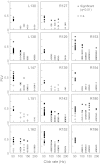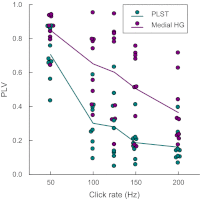Coding of repetitive transients by auditory cortex on posterolateral superior temporal gyrus in humans: an intracranial electrophysiology study
- PMID: 23236002
- PMCID: PMC3602837
- DOI: 10.1152/jn.00718.2012
Coding of repetitive transients by auditory cortex on posterolateral superior temporal gyrus in humans: an intracranial electrophysiology study
Abstract
Evidence regarding the functional subdivisions of human auditory cortex has been slow to converge on a definite model. In part, this reflects inadequacies of current understanding of how the cortex represents temporal information in acoustic signals. To address this, we investigated spatiotemporal properties of auditory responses in human posterolateral superior temporal (PLST) gyrus to acoustic click-train stimuli using intracranial recordings from neurosurgical patients. Subjects were patients undergoing chronic invasive monitoring for refractory epilepsy. The subjects listened passively to acoustic click-train stimuli of varying durations (160 or 1,000 ms) and rates (4-200 Hz), delivered diotically via insert earphones. Multicontact subdural grids placed over the perisylvian cortex recorded intracranial electrocorticographic responses from PLST and surrounding areas. Analyses focused on averaged evoked potentials (AEPs) and high gamma (70-150 Hz) event-related band power (ERBP). Responses to click trains featured prominent AEP waveforms and increases in ERBP. The magnitude of AEPs and ERBP typically increased with click rate. Superimposed on the AEPs were frequency-following responses (FFRs), most prominent at 50-Hz click rates but still detectable at stimulus rates up to 200 Hz. Loci with the largest high gamma responses on PLST were often different from those sites that exhibited the strongest FFRs. The data indicate that responses of non-core auditory cortex of PLST represent temporal stimulus features in multiple ways. These include an isomorphic representation of periodicity (as measured by the FFR), a representation based on increases in non-phase-locked activity (as measured by high gamma ERBP), and spatially distributed patterns of activity.
Figures









Similar articles
-
Electrocorticographic delineation of human auditory cortical fields based on effects of propofol anesthesia.Neuroimage. 2017 May 15;152:78-93. doi: 10.1016/j.neuroimage.2017.02.061. Epub 2017 Feb 27. Neuroimage. 2017. PMID: 28254512 Free PMC article.
-
Coding of repetitive transients by auditory cortex on Heschl's gyrus.J Neurophysiol. 2009 Oct;102(4):2358-74. doi: 10.1152/jn.91346.2008. Epub 2009 Aug 12. J Neurophysiol. 2009. PMID: 19675285 Free PMC article.
-
Functional localization of auditory cortical fields of human: click-train stimulation.Hear Res. 2008 Apr;238(1-2):12-24. doi: 10.1016/j.heares.2007.11.012. Epub 2007 Dec 8. Hear Res. 2008. PMID: 18207680 Free PMC article.
-
Representation of temporal sound features in the human auditory cortex.Rev Neurosci. 2011;22(2):187-203. doi: 10.1515/RNS.2011.016. Rev Neurosci. 2011. PMID: 21476940 Review.
-
Auditory processing in the human cortex: An intracranial electrophysiology perspective.Laryngoscope Investig Otolaryngol. 2017 Apr 12;2(4):147-156. doi: 10.1002/lio2.73. eCollection 2017 Aug. Laryngoscope Investig Otolaryngol. 2017. PMID: 28894834 Free PMC article. Review.
Cited by
-
Electrophysiology of the Human Superior Temporal Sulcus during Speech Processing.Cereb Cortex. 2021 Jan 5;31(2):1131-1148. doi: 10.1093/cercor/bhaa281. Cereb Cortex. 2021. PMID: 33063098 Free PMC article.
-
Dynamic speech representations in the human temporal lobe.Trends Cogn Sci. 2014 Sep;18(9):472-9. doi: 10.1016/j.tics.2014.05.001. Epub 2014 Jun 3. Trends Cogn Sci. 2014. PMID: 24906217 Free PMC article. Review.
-
Neural Correlates of Vocal Auditory Feedback Processing: Unique Insights from Electrocorticography Recordings in a Human Cochlear Implant User.eNeuro. 2021 Jan 28;8(1):ENEURO.0181-20.2020. doi: 10.1523/ENEURO.0181-20.2020. Print 2021 Jan-Feb. eNeuro. 2021. PMID: 33419861 Free PMC article.
-
Electrocorticographic delineation of human auditory cortical fields based on effects of propofol anesthesia.Neuroimage. 2017 May 15;152:78-93. doi: 10.1016/j.neuroimage.2017.02.061. Epub 2017 Feb 27. Neuroimage. 2017. PMID: 28254512 Free PMC article.
-
Evolving perspectives on the sources of the frequency-following response.Nat Commun. 2019 Nov 6;10(1):5036. doi: 10.1038/s41467-019-13003-w. Nat Commun. 2019. PMID: 31695046 Free PMC article. Review.
References
-
- Bao S, Chang EF, Woods J, Merzenich MM. Temporal plasticity in the primary auditory cortex induced by operant perceptual learning. Nat Neurosci 7: 974–981, 2004 - PubMed
-
- Benjamini Y, Drai D, Elmer G, Kafkari N, Golani I. Controlling the false discovery rate in behavior genetics research. Behav Brain Res 125: 279–284, 2001 - PubMed
-
- Benjamini Y, Hochberg Y. Controlling the false discovery rate: a practical and powerful approach to multiple testing. J Royal Stat Soc B Methodol 57: 289–300, 1995
-
- Brugge JF, Volkov IO, Garell PC, Reale RA, Howard MA., III Functional connections between auditory cortex on Heschl's gyrus and on the lateral superior temporal gyrus in humans. J Neurophysiol 90: 3750–3763, 2003 - PubMed
Publication types
MeSH terms
Grants and funding
LinkOut - more resources
Full Text Sources
Other Literature Sources
Medical

